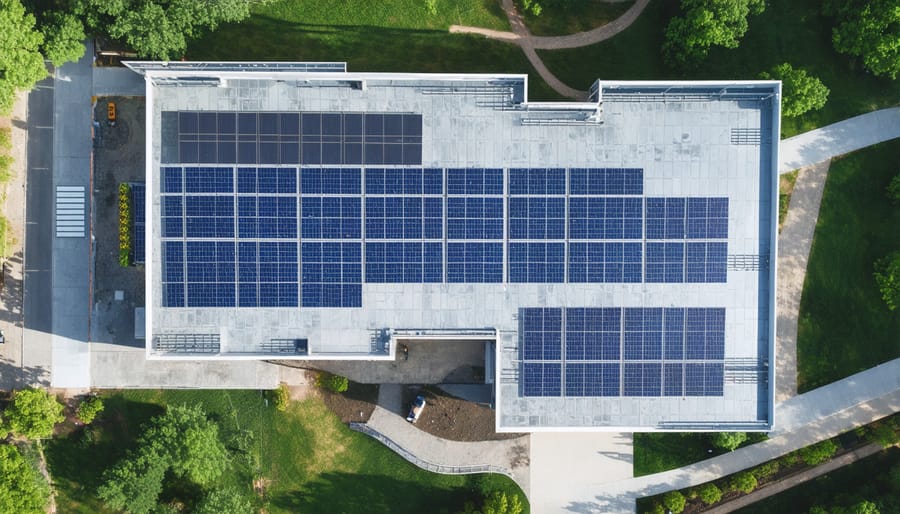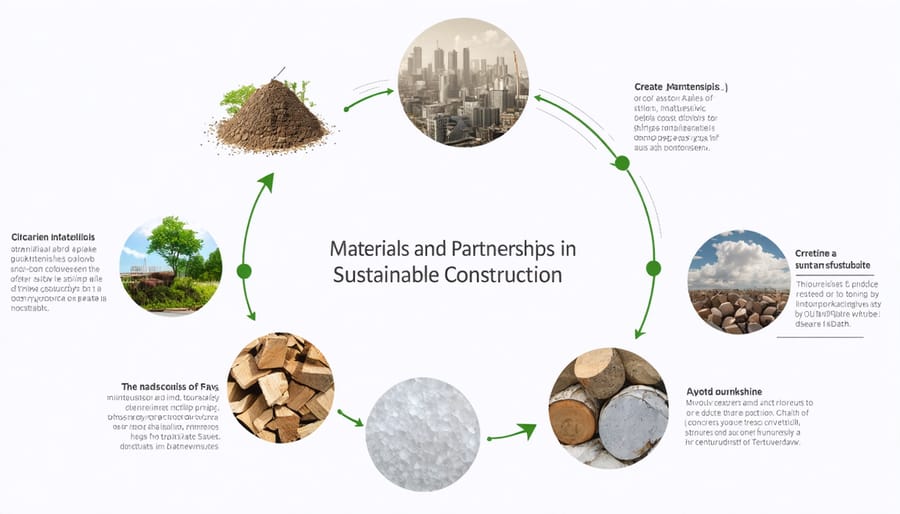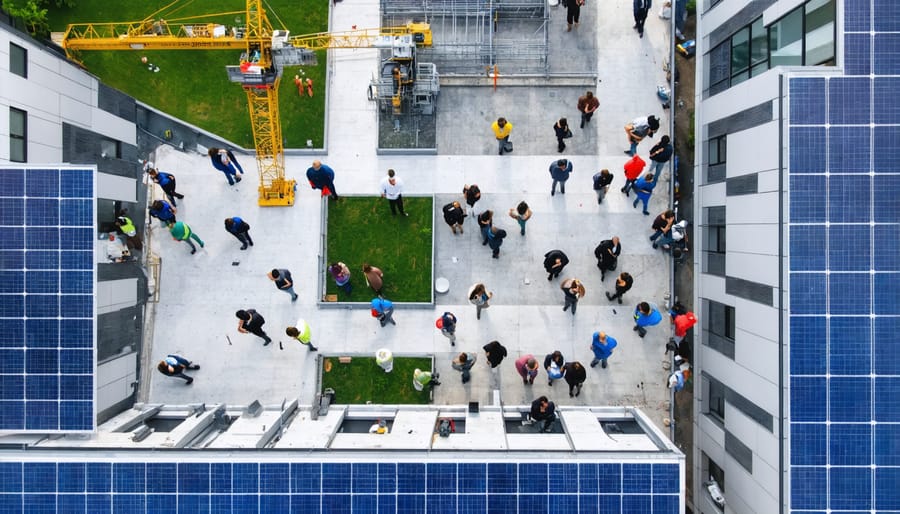The construction industry stands at a pivotal crossroads, where implementing sustainable construction strategies has become not just an environmental imperative but a crucial business advantage. With buildings accounting for 40% of global energy consumption and 36% of CO2 emissions, the transformation toward sustainable practices represents both our greatest challenge and opportunity. Leading construction firms are already demonstrating that eco-conscious building methods can reduce operational costs by up to 30% while increasing property values by an average of 7%.
The integration of advanced materials, innovative design techniques, and smart technologies is revolutionizing how we approach construction sustainability. From carbon-neutral concrete alternatives to integrated renewable energy systems, these solutions are reshaping industry standards and regulatory frameworks. Moreover, with 73% of commercial real estate clients now prioritizing sustainability in their investment decisions, adopting these practices has become essential for maintaining competitive advantage in today’s market.
This shift toward sustainable construction isn’t just about environmental stewardship—it’s about creating resilient, future-proof buildings that deliver superior performance, reduce long-term operational costs, and meet increasingly stringent regulatory requirements.
The Evolution of Construction Industry Partnerships
Key Stakeholders in Sustainable Construction
Successful sustainable construction relies on the coordinated efforts of multiple stakeholders, each bringing unique expertise and responsibilities to the project lifecycle. Developers play a pivotal role by setting sustainability goals and allocating resources, while architects integrate green design principles and innovative solutions into building plans. Environmental consultants provide crucial guidance on regulations, certifications, and impact assessments, ensuring projects meet or exceed sustainability standards.
Material suppliers are increasingly important stakeholders, responsible for sourcing and providing eco-friendly building materials and maintaining transparent supply chains. General contractors and construction managers oversee the practical implementation of sustainable practices on-site, coordinating with subcontractors to ensure proper execution of green building techniques.
Engineering teams contribute vital technical expertise in areas such as energy efficiency, water management, and renewable energy systems. Building operators and facility managers become key stakeholders post-construction, maintaining the building’s sustainable features and monitoring performance metrics. Local authorities and regulatory bodies also play a critical role by establishing and enforcing environmental standards and building codes.
Success in sustainable construction depends on early stakeholder engagement and maintaining clear communication channels throughout the project lifecycle, fostering innovation and ensuring alignment with sustainability objectives.

Benefits of Collaborative Sustainability
Collaborative sustainability in construction yields substantial benefits through the synergy of multiple stakeholders working toward common environmental goals. When developers, architects, contractors, and suppliers align their sustainability objectives, projects typically see a 20-30% reduction in resource waste and improved cost efficiency.
Partnership approaches enable knowledge sharing and innovation diffusion across the supply chain. For instance, when material suppliers collaborate with contractors, they can develop and implement more effective recycling programs and optimize delivery schedules to reduce carbon emissions. These partnerships often result in better material selection and more efficient construction methods.
Financial advantages are equally significant. Collaborative projects frequently benefit from shared risk management, reduced operational costs, and increased access to green building incentives. Studies show that sustainable buildings developed through partnership approaches achieve 25% higher energy efficiency compared to traditional construction methods.
Furthermore, stakeholder collaboration leads to enhanced quality control, faster problem resolution, and more innovative solutions. When combined with integrated design processes, these partnerships create a foundation for long-term sustainability success, ensuring that environmental considerations are embedded throughout the project lifecycle rather than treated as afterthoughts.
Innovative Partnership Models Driving Change
Public-Private Partnerships
Successful implementation of sustainable construction practices often relies on effective public-private partnerships that bridge the gap between government initiatives and industry capabilities. These collaborations have proven instrumental in driving innovation and establishing comprehensive frameworks for sustainable development.
Recent examples demonstrate the power of such partnerships. The Green Building Alliance program, launched in 2020, brought together government agencies, construction firms, and environmental experts to develop standardized sustainability metrics. This initiative resulted in a 30% reduction in carbon emissions across participating projects and established new benchmarks for energy-efficient construction.
Government incentives, combined with private sector expertise, have accelerated the adoption of sustainable technologies. Tax credits for LEED-certified buildings, coupled with industry investment in renewable materials and energy systems, have created a robust ecosystem for sustainable construction. Notable success stories include the Urban Sustainability Initiative in Singapore, where government funding matched private investment to create one of Asia’s largest green building developments.
These partnerships also facilitate knowledge transfer and capacity building. Regular industry forums, joint research programs, and shared training initiatives ensure that sustainable practices evolve with technological advancements. The Construction Innovation Hub, a collaboration between government research bodies and leading construction firms, exemplifies how shared resources can accelerate the transition to sustainable building methods.
Supply Chain Integration
Supply chain integration in sustainable construction demands a comprehensive approach to partnerships and material sourcing that extends beyond traditional procurement methods. By establishing vertical partnerships with suppliers, manufacturers, and logistics providers, construction companies can ensure environmental responsibility throughout the entire value chain.
These integrated relationships enable better tracking and verification of sustainable materials, from raw material extraction to final delivery on-site. Leading construction firms are implementing digital supply chain management systems that provide real-time visibility into material sources, transportation methods, and carbon footprints. This transparency allows for more informed decision-making and helps maintain sustainability standards across all touchpoints.
Strategic partnerships with suppliers who share sustainability commitments have proven particularly effective. For instance, major construction companies are working directly with cement manufacturers who use alternative fuels and raw materials, reducing the environmental impact of this crucial building material. Similarly, partnerships with local suppliers help minimize transportation distances and associated emissions while supporting regional economies.
Advanced logistics planning through integrated supply chains also reduces waste and improves efficiency. Just-in-time delivery systems, coordinated through digital platforms, minimize on-site storage requirements and reduce material damage. Furthermore, reverse logistics partnerships ensure proper handling of construction waste, enabling better recycling and reuse of materials.
To maximize these benefits, construction companies should establish clear sustainability criteria for supplier selection and maintain ongoing performance monitoring through sophisticated tracking systems. This approach ensures continuous improvement and accountability throughout the supply chain network.

Case Studies: Successful Sustainability Partnerships
The Green Building Alliance Initiative
The Green Building Alliance Initiative (GBAI) stands as a remarkable example of successful multi-stakeholder collaboration in sustainable construction. Launched in 2018, this partnership brings together 47 construction companies, 12 architectural firms, 8 major developers, and various government agencies to accelerate the adoption of green building practices across the industry.
The initiative’s core achievement lies in its innovative approach to stakeholder engagement. By establishing a shared governance model, GBAI created working groups focused on specific sustainability challenges, from materials sourcing to energy efficiency. Each stakeholder contributes unique expertise while sharing risks and resources, resulting in a more robust and practical implementation framework.
One of GBAI’s most successful projects includes the development of a standardized sustainability metrics system, now adopted by over 200 construction projects nationwide. This system has helped reduce carbon emissions by 35% across participating projects while achieving an average of 40% reduction in water consumption.
The partnership has also pioneered innovative climate resilience solutions through its pilot program in urban development. Working with local authorities, GBAI members have implemented green roof technologies, sustainable drainage systems, and renewable energy integration in commercial buildings, demonstrating the practical benefits of collaborative sustainable construction.
Key success factors include transparent communication channels, clear accountability mechanisms, and shared decision-making processes. The initiative’s comprehensive stakeholder engagement framework ensures that all partners maintain active involvement while working toward common sustainability goals, making it a model for future industry collaborations.
Circular Economy Construction Network
The Circular Economy Construction Network (CECN) represents a groundbreaking partnership initiative transforming how the construction industry approaches waste management and resource utilization. This collaborative platform connects contractors, suppliers, and waste management specialists to create closed-loop material cycles within regional construction ecosystems.
At its core, CECN operates through a digital marketplace where construction companies can list surplus materials, recyclable waste, and salvaged components. This system has demonstrated remarkable success, with participating companies reporting an average 47% reduction in waste disposal costs and a 35% decrease in raw material expenses within the first year of implementation.
The network’s innovative tracking system employs blockchain technology to monitor material flows, ensuring transparency and traceability throughout the supply chain. This has proven particularly valuable for climate-adaptive construction projects where material providence and sustainability credentials are crucial.
Recent case studies highlight the network’s impact. In Greater Manchester, a consortium of 15 construction firms achieved a 65% reduction in landfill waste through material sharing and reprocessing initiatives. The program’s success has led to its adoption across multiple regions, with over 200 companies now actively participating.
The network also facilitates knowledge sharing through regular workshops and technical forums, enabling members to optimize their waste reduction strategies and discover innovative reuse applications. This collaborative approach has fostered the development of new recycling technologies and alternative materials, demonstrating how industry partnerships can drive sustainable innovation in construction.
Implementation Strategies for Construction Firms

Partnership Development Framework
Building effective partnerships in sustainable construction requires a systematic approach that prioritizes mutual benefits and long-term commitment. The process begins with identifying potential partners whose sustainability goals align with your organization’s objectives. This includes suppliers, technology providers, research institutions, and other stakeholders within the construction ecosystem.
The next crucial step involves conducting thorough due diligence to evaluate potential partners’ track records in sustainable practices, financial stability, and technical capabilities. This assessment should include reviewing their previous projects, certifications, and commitment to environmental standards.
Successful partnership development relies on establishing clear governance structures and communication protocols. Create a formal framework that outlines roles, responsibilities, and decision-making processes. This should include specific sustainability targets, measurement criteria, and reporting mechanisms.
Implementation requires a phased approach, starting with pilot projects to test collaboration effectiveness. Regular performance reviews and feedback sessions help identify areas for improvement and ensure alignment with sustainability goals.
Risk-sharing mechanisms and dispute resolution procedures should be clearly defined in partnership agreements. This includes addressing intellectual property rights, cost-sharing arrangements, and environmental liability considerations.
Finally, establish knowledge-sharing platforms to facilitate continuous learning and innovation. This might involve joint research initiatives, training programs, or collaborative workshops focused on sustainable construction techniques. Regular evaluation of partnership outcomes against predetermined sustainability metrics ensures continuous improvement and long-term success.
Measuring Partnership Success
Evaluating partnership success in sustainable construction requires a systematic approach through well-defined Key Performance Indicators (KPIs) and measurement frameworks. Successful organizations typically monitor both quantitative and qualitative metrics to assess partnership effectiveness.
Primary KPIs should include environmental impact measurements such as carbon footprint reduction, waste diversion rates, and energy efficiency improvements. These metrics can be tracked through specialized software and regular audits. Financial indicators, including cost savings from shared resources and reduced material waste, provide tangible evidence of partnership benefits.
Project-specific metrics often encompass on-time delivery rates, safety performance, and innovation implementation success rates. Regular partnership health assessments should evaluate communication effectiveness, resource allocation efficiency, and mutual goal achievement. Industry leaders recommend quarterly reviews of these metrics, supplemented by annual comprehensive evaluations.
Many successful partnerships implement a balanced scorecard approach, incorporating sustainability targets, operational efficiency, stakeholder satisfaction, and financial performance. This method ensures a holistic view of partnership outcomes and identifies areas for improvement.
Documentation of lessons learned and best practices is crucial for continuous improvement. Leading construction firms maintain detailed records of partnership milestones, challenges overcome, and innovations developed, creating valuable knowledge bases for future collaborations.
Regular stakeholder surveys and feedback sessions provide qualitative insights into partnership effectiveness, complementing quantitative measurements and ensuring comprehensive evaluation of sustainable construction initiatives.
As we look ahead, the future of sustainable construction lies in the strength of strategic partnerships and collaborative innovation. The industry has made significant strides in implementing eco-friendly practices, but the challenges of climate change and resource scarcity demand even greater cooperation among stakeholders.
Key takeaways from successful sustainable construction partnerships demonstrate that integration of expertise across the supply chain, from materials manufacturers to end-users, creates the most impactful results. The adoption of digital technologies, combined with sustainable building practices, has proven particularly effective when supported by cross-sector collaboration.
Looking forward, we can expect to see more formalized partnership frameworks emerging, especially as governments worldwide implement stricter environmental regulations. Industry leaders are increasingly recognizing that sustainable construction isn’t just an environmental imperative but a competitive advantage that drives innovation and creates long-term value.
The success of future sustainable construction initiatives will depend heavily on:
– Continued investment in research and development through public-private partnerships
– Enhanced knowledge sharing across international borders
– Standardization of sustainable building practices and metrics
– Integration of emerging technologies with traditional construction methods
– Development of skilled workforce through collaborative training programs
As the construction industry evolves, partnerships will remain crucial in addressing complex sustainability challenges while delivering practical, cost-effective solutions. The path forward requires commitment, innovation, and most importantly, collaboration among all stakeholders in the construction ecosystem.

